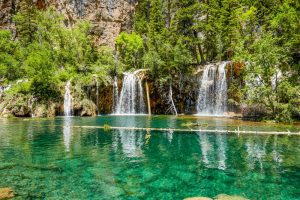River rocks vary in size, shape, and color. You will find river rocks in riverbeds and on beaches. They are round and worn smooth from the tumbling action of the water.
River rocks can be igneous, metamorphic, or sedimentary. The type of rock depends on the location of the river.
The weight of a yard of river rock depends on the type of rock. On average, one cubic yard of river rock weighs on average 1.3 tons or 2,600 pounds.
Table of Contents
What are the different types of river rock?
There are three major types of river rock, igneous, metamorphic, and sedimentary.
The type of rock that enters the river depends on the geographic location. Rocks form through physical changes including cooling, melting, compacting, and erosion.
Igneous rocks

When rock heats to the melting point of magma, igneous rocks form. Granite, for example, is a type of igneous rock. It forms as magma cools and crystallizes.
Granite is the most common type of river rock used in landscaping as ground cover or decoration.
Granite is a composite of feldspar and quartz, and these minerals give granite river rocks a banded and speckled appearance.
Granite river rocks come in a variety of colors because of the nature of igneous rocks. Colors range from purple, green, russet, gray, black, and white.
Metamorphic river rock

When an existing rock changes into a new rock due to heat and pressure change, a metamorphic rock forms. Both igneous and sedimentary rocks can change into metamorphic rocks.
The most used metamorphic rock in landscaping is schist river rock. Schist is a high luster, metamorphic rock formed within the earth.
It has the appearance of having flakey layers that split apart. These layers form under extreme pressure and heat.
Sedimentary rocks

Sedimentary rocks form when sediments cement together through compaction or recrystallization; sedimentary rocks form in muddy and silty environments.
Sedimentary rocks form on the ocean floors, in shallow seas, and in river floodplains.
The most common types of sedimentary rocks are limestone, shale, and sandstone. In landscaping, shale is the most used sedimentary rock. Shale is a decorative mineral and is used as an ornamental mulch.
What are the geographical locations of river rocks on the planet?
River rocks are all over the planet in all riverbeds, riverbanks, and ocean beaches. Rain and erosion cause rocks to fall into the river.
These rocks are sedimentary, metaphoric, or igneous depending on the specific geographical location.
The rocks move downstream by the current of the river. As the rocks travel downstream, they get tumbled by the motion of the water.
This causes the river rocks to become smooth and round. The size and color of river rock depend on the type of rock.
What is the rock cycle?
The rock cycle is the changing of rock types over time. Igneous, metamorphic, and sedimentary rocks change from one to the other over time.
This change results from a variety of physical changes. For instance, melting lava turns a metamorphic rock into igneous rock.
In the rock cycle, an igneous rock when exposed to heat and pressure becomes a metamorphic rock. If weathered, an igneous rock will become a sedimentary rock.
A sedimentary rock becomes a metamorphic rock when it experiences heat and pressure.
What are river rocks used for?

River rocks have many uses in landscaping, including building fountains and preventing erosion. You can use river rocks to create waterfalls and fountains.
You can also use them to make dry riverbeds that help divert water away from buildings. Additionally, river rocks can prevent soil erosion.
How big are river rocks?
River rocks come in a wide range of sizes. Some river rocks are very small measuring three-eighths of an inch while other river rocks are large measuring about six inches.
The size of river rock you need depends on how you plan on using them.
How are river rocks used in landscaping?
How you use river rocks in your landscape depends on the size of the rock. One idea is to use large slabs of rock to make a staircase. Another idea is to create a pathway.
To create a pathway, you make a path of smaller river rocks. Then place larger, flat rocks on top of the gravel as steppingstones.

Consider using different shapes and colors to create a unique pattern.
You will want to keep the weeds from growing through the river rocks in your landscape. To do this, use landscaping fabric. Using landscaping fabric is easy.
It works best if you remove any vegetation before laying down the landscaping fabric. After the area is prepared, lay the landscape fabric down where you want to place the river rock.
After anchoring it in place, add the river rock on top of the landscaping fabric.
River rock has a tendency to move out of place. To keep the river rocks in place, you will need to install some sort of border. There are several different options.
You can use larger stones as a border, or you can install plastic edging strips. Another option is a wooden border made of pressure-treated timber or natural logs.
How much area can I cover with a yard of river rock?

The area a yard of river rock will cover depends on the depth of the layer of rock. A cubic yard of river rock will cover about seventy-five to one hundred seventy square feet.
That is at a depth of two to four inches deep.
Where can I get river rock?
You can get river rock from a commercial retailer or from public lands. You can buy river rock in a bag or by the truckload. Most local landscaping companies will deliver river rock to your location.
You can collect small amounts of rocks on public lands for personal use. If you are collecting for personal use, you do not need a permit.
You cannot collect rocks in some areas, such as wilderness areas. Always check with your local public lands office before collecting rocks.
How do I make river rock look wet?
There are several ways to get your river rocks to look wet. You can use a small tumbler. This will polish the rock, giving it a shiny, wet look.
Other methods involve coating the river rocks with a manufactured product. Options include a polyurethane mixture that you paint onto the river rock. Polyurethane coating lasts about fifteen years.
Natural oils, resins, and silicon aerosols are other options. Oils penetrate the rock’s pores, which causes a shiny, wet look. Resins are good to use as a second coat to create an extra shine.
The location of rivers on earth – fast facts
Fun facts about the size, number, and location of the planet’s rivers.
- There are one-hundred sixty-five major rivers in the world.
- Seventy-six of the rivers are over one-thousand miles long.
- The Nile River is the longest river in the world. It is 4,132 miles long.
- Russia has the most rivers over six hundred miles long.
How much of the world is covered by rivers?

Rivers and streams cover a very small amount of the earth’s surface. Less than half a percent of the earth’s land surface is a stream or river. That is about 773,000 square kilometers or 298,457 square miles.
For comparison, the entire surface of the earth is 196.9 million square miles.
Rivers and river rock factoids
Have you ever wondered how many rivers are in the United States? Or perhaps you have wondered how deep is the deepest river? Read on to learn fun facts about rivers and river rocks.
How many gallons of water are in one cubic mile?
There are more than a trillion gallons of water in a cubic mile. A cubic mile is a volume of measurement with all sides equaling one mile. A mile is 5,280 feet in length.
How deep is the deepest river in the world?
The deepest river in the world is the Congo River in Africa. The deepest part of the Congo River is 720 feet. Light cannot penetrate the waters at that depth.
The Congo River is the second-longest river in Africa. Its length is approximately 2,920 miles.
What is the deepest river in the United States?

The Hudson River is the deepest river in the United States. At its deepest point, it is 200 feet deep. The Hudson River flows through the State of New York.
The final segment of the Hudson River creates the border between New York and New Jersey.
How many rivers are in the United States?
The United States has more than a quarter-million rivers, creeks, and streams. The total length of all the rivers, creeks, and streams is about 3.5 million miles.
What is the largest river in the United States?
The largest river in the United States by volume is the Mississippi River. It discharges approximately 593,003 cubic feet per second.
The Mississippi River is the fifteenth largest river in the world by volume.
What is the longest river in the USA?

The longest river in the United States is the Missouri River. It measures approximately 2,540 miles long. The Missouri River begins in the northwestern corner of Missouri and flows through the entire state.
The Missouri River connects to the Mississippi River near St. Louis, Missouri.
How long does it take for a river rock to form?
The time it takes for a river rock to form depends on its exposure to the elements. Temperature and pressure have a strong influence on the rock’s development.
Regardless of the environment, it can take thousands of years for a rock to become a river rock.
What are the ten most common types of river rocks?
The ten most common types of river rocks are quartz, feldspar, granite, schist, basalt, limestone, jasper, shale, and agates. The geographical environment determines the location of each type of river rock.

















